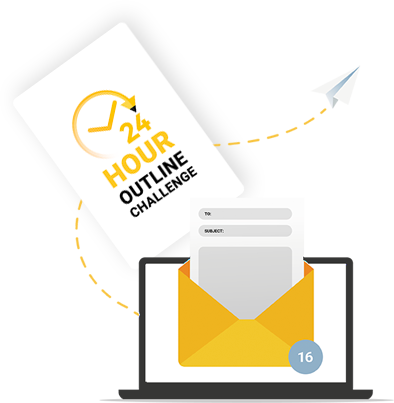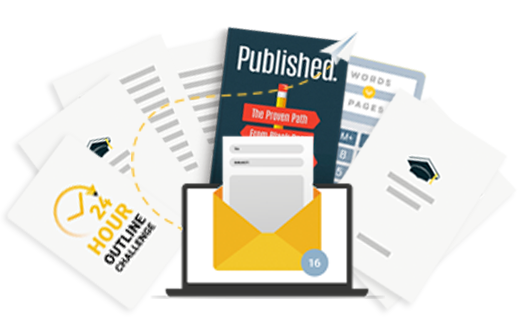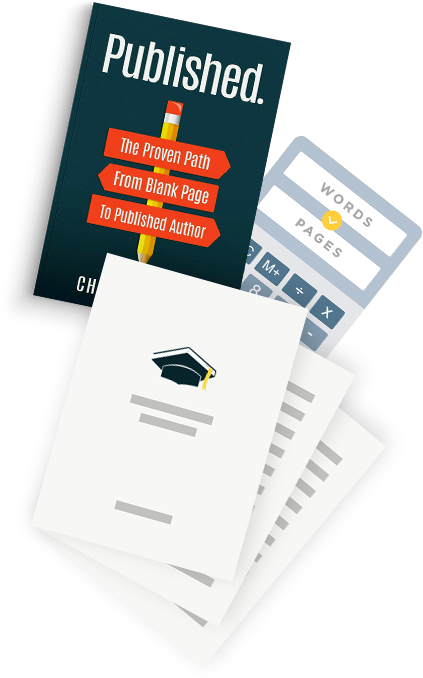In this day and age, there are a ton of book publishing options. With the rise of the self-publishing industry (and subsequent dip in traditional publishing), your options to publish are wide and far.
Here at Self-Publishing School, we understand the power of self-publishing, which is why we have our Become a Bestseller program, where we teach people how to maintain control and become a bestseller.
However, there are a ton of other options, and we wanted to make sure you had all the information possible in order to make the decision that’s best for you and your needs as an author.
Here are your book publishing options:
Self-Publishing vs Traditional Publishing
When thinking about your publishing options, there are two main avenues to take into consideration: self-publishing and traditional publishing.
We’ll go into more detail in each individual section below, but just know this is one of the biggest decisions you’ll have to decide on if you want to be an author.
The short overview is this:
- Self-publishing gives you all creative control, is faster to publish, gives you full royalties, with more upfront investments
- Traditional publishing takes a lot longer, no upfront investments, but you make a small fraction of royalties per book
One of the biggest things to keep in mind between these two core publishing options is how much you can actually bring home in pay from each:
Here’s an example of a comparison in earnings per publishing option, using two of our own Become a Bestseller students Alexis and Justin Black with their book Redefining Normal as an example:
Traditional Earnings:
Book retail price: $14.99
Initial Royalty Rate: 10%
Income per book: $1.79
Books Sold: 6000
Earnings: $10,740
Self-Published Earnings:
Book retail price: $14.99
Initial Royalty Rate: 60%
Income per book: $5.74
Books Sold: 6000
Earnings: $34,440
We actually compiled a ton of data on self-publishing versus traditional publishing you can find in this free download here:
Publishing Options: Where to Publish a Book & How to Choose
Not everyone will be a good fit for all of these publishing options. You have to think about your goals as an author, what you want to make financially, and where you see yourself in the long-term—as well as how many books you want to publish and how frequently.
All of these are important to consider when making your decision, but we want to give you all the information so that your decision is easier.
#1 – Self-Publishing
If self-publishing isn’t on your radar, you’re severely missing out on a huge opportunity. We truly believe this is the best publishing avenue for the large majority of people.
This is why Self-Publishing School started in the first place. Chandler Bolt (the founder and CEO) started this company because he had such a massive success with his first bestselling book.
Since, he’s published 5 other bestsellers, and he gave all his secrets for doing that away in our Become a Bestseller program.
Now, that being said, there are things to think about when it comes to self-publishing.
So what is self-publishing?
Self-publishing is when you have complete ownership and control of your book and its rights, and you can publish on any medium that allows for it (including Amazon Publishing, Barnes & Noble, Nook, and more).
Difficulty to publish:
It’s very easy to self-publish a book. In fact, pretty much anyone with access to Amazon’s publishing platform can do it.
But that doesn’t mean everyone should, nor should you publish a book that’s not ready (or not of high quality), which is why we have our programs in the first place.
Timeframe to publish:
Our students publish in as little as 90 days with our process for going from blank page (yes, nothing written!) to a fully published book. You can take longer to publish, and many students in our Fundamentals of Fiction program often do take longer since fiction can be more extensive.
Creative control:
This is the best part! You have 100% of the creative control over everything from your book’s content to its title, cover, everything. Especially the rights to your book!
Marketing responsibility:
This is all on you—just like it is with traditional publishing, which you’ll learn more about down below. Thankfully, there are a ton of resources online to learn how to market a book, as well as our Sell More Books program to increase your book sales.
Royalty rate:
When publishing through Amazon, your royalty rate will be anywhere from 35% – 70% depending on your book’s retail price. SelfPublishing.com has a fantastic book royalties calculator right here that you can check out for a comparison as well.
Cost to publish:
Self-publishing has a higher upfront investment and cost to publish. These can range anywhere from $300 – $1200+ for high-quality editing, book cover design, and more.
But do keep in mind, you make a lot more in royalties back straight away.
Book production (cover design, editing, etc.):
This is all on you. From the cover design to the book editing (yes you have to get it edited if you want it to do well) all the way to the inside formatting is up to you.
Thankfully, there are resources to help you do all of this right, and we cover this entire process in our programs for our students, as we’ve seen this is one of the most difficult parts of self-publishing.
Questions to ask if you think self-publishing is right for you:
- Do you need 100% creative control?
- Do you have the ability to invest upfront for a higher royalty rate later?
- Can you effectively market your book (even with help)?
- Do you want to write and publish multiple books quickly?
If you answered yes to the above, self-publishing is likely your best option, and you can learn more about how to do that with our free training. Just click the image below!
#2 – Traditional Publishing
Traditional publishing is what we grew up learning was “publishing”: You get an agent through querying your book, that agent pitches your story to publishers, they choose to buy your book from you, and it gets published a while later!
Let’s look at some details about this traditional publishing option.
Difficulty to publish:
Very high. The traditional publishing industry is really hard to get into. It’s not impossible, but it often takes writers years just to land an agent. And then they have to wait until their manuscript is bought, which isn’t guaranteed.
Many will say traditional produces “better” books or you’re a “better” writer if you publish traditionally, but that’s not true. All this proves is that you have a book idea that’s “hot” and “trending” in the market: remember, publishing houses are after one thing and that’s book sales. If it’ll sell, they’ll purchase it, which means unless it’s a trending topic or book idea, you likely won’t get a book deal.
Timeframe to publish:
If we start the timeline to publish after your agent sells your manuscript, meaning a publishing house has purchased your book rights, it can still take up to 2 years for your book to actually publish.
And this doesn’t take into consideration the time spent trying to get an agent and the time it takes your agent to sell your book. You’re looking at a 2-4 year time period unless you get very lucky or have traditional publishing connections.
Creative control:
You don’t really have much creative control with this publishing option.
Ultimately, the publisher buys your book rights for the idea, but this is subject to change based on what your editor sees as selling the most.
Unfortunately, this can be everything from the main characters, the title, the ending, and even major plot points. The upside is that publishers do know what sells, so this could give your book a better chance of “taking off.”
Just know that you’ll have to make sacrifices with creative control through traditional publishing.
Marketing responsibility:
This is on you! Unless you’re a “big name,” (and even then) you do the heavy lifting when it comes to marketing your book.
This is one of the biggest misconceptions about the traditinoal publishing industry. Many want to go with this publishing option because they think the publishing house will market their book, and they do, but only to a certain extent.
The bulk of the marketing is up to you, and this is increasingly more evident as book agents continue to ask about your author platform size as a decision criterion for representing you or not.
Royalty rate:
Many traditionally published authors can expect to make 10% – 12% and (very rarely) up to 15% royalties on their books. As you can see, this is significantly lower than self-publishing due to the publisher taking a big cut to pay for the editing, cover design, and everything that goes into it, as well as your agent taking a cut.
You do get an “advance” if you sign a book deal. This is a large sum of money, usually under $15,000 for new authors, that you have to make back in book sales before you actually get a royalty check.
Many traditionally published authors never see a royalty check because their books never sell more than their advance’s worth after publication.
Cost to publish:
Time. This is the real true cost of the traditional publishing option. If anyone tries to get you to pay them, this is not traditional publishing and is likely a hybrid or a vanity publisher (for the latter, RUN!).
Book production (cover design, editing, etc.):
This is all done in-house at the publisher. They have a cover made, editing completed, formatting finished, as well as book distribution—meaning getting your book in bookstores across the nation.
You can learn more about the main differences between self-publishing and traditional publishing by watching the video below:
Here are some questions to ask if you want to go with this publishing option:
- Will you be okay with altering your story, characters, and plot?
- Do you want to publish less frequently, at a book every one or two years?
- Do you want to relinquish ownership over the cover design and more?
- Will you be okay with a smaller royalty rate for your book?
- Are you willing to spend a year or more querying just to find an agent?
If you answered yes to all of those, this avenue might be for you!
#3 – Hybrid Publisher
If you’re not sold on either self-publishing or traditional publishing, there is another option called hybrid publishing.
Hybrid publishing is just as it sounds: a combination of both self-publishing and traditional publishing.
Most often a hybrid publisher will have specific criteria for authors they work with and will have the distribution opportunities self-publishing doesn’t (like nation-wide bookstores).
One distinguishing factor here: the author usually has to make some sort of investment in order to publish through them.
Difficulty to publish:
This depends entirely on the publisher’s rules and regulations for new authors. Most don’t just take anyone in off the street, which means it is more difficult than self-publishing, though usually not as much so as traditional.
Timeframe to publish:
This is another differentiating factor. Hybrid publishers vary so greatly that most of these will depend on the specific publishing house. However, you can expect an elongated path to publishing here as well.
Creative control:
Since the publisher in this case usually deals with the book cover, title, and such, your creative control is at more risk here. However, most of these publishing houses are more likely to work with you to come to an agreement whereas traditional publishing houses don’t give you much of a choice.
Marketing responsibility:
Again, as with any publishing option, marketing responsibilities fall to you, the author. Though because this is a hybrid publisher, you’ll have more exposure due to their distribution capabilities (which is a note to make sure this is included if you choose this option).
Royalty rate:
Since this also varies, all we have is an approximation range: you can expect roughly 40% – 60% in royalty rates depending on the deal you make. This is definitely higher than traditionally published authors make, but you’ll make less than self-publishing simply because the publisher will still get a cut.
Cost to publish:
Guess what, the cost to publish here depends as well! Different hybrid publishers work on different models, which means their revenue will be earned differently. That said, some authors pay a large sum to work with hybrid publishers, as well as give up a chunk of their royalties.
Book production (cover design, editing, etc.):
This usually goes through the hybrid publisher, and the process is much like that of traditional publishing. This means you don’t have to worry about any of this and that you also don’t get to change or alter any of this.
#4 – Vanity Publisher
CAUTION!!
We wanted to include this in the options because it is an option you’ll see out there. However, it is not an option to consider.
It’s here so you can know what to look for when a vanity publisher is involved in order to AVOID one. We do not recommend this option.
We wrote a blog post all about vanity press scams here, what they are, and why you should avoid them at all costs.
In other words: you may see people who look like hybrid publishers but are not. Do not work with them!
So what type of publisher is Self-Publishing School?
None! We’re not a publishing option, we’re an online education school that teaches you how to successfully self-publish a book so you can save time, money, (and tears), while earning a steady income from your books.
You can learn more about us from our What We Do page, including all the various specialty programs we have (nonfiction, fiction, children’s, marketing, and more!).




